The Chinese New Year, known to locals as the Lunar New Year, is a time for lively festivities and delectable cuisine. Each ingredient of every dish is loaded with meaning, symbolizing omens and blessings of long life, good fortune, and so much more.
There are many traditional dishes you might like to try, ranging from savory meals to complimentary desserts. Many have become immensely popular and found their way into Western culture, along with their recipes as well. To get a taste of Chinese culture in your home, try the dishes below when you welcome the next New Year. (10 lucky chinese new year food )
Nian Gao (“Year Cake,” or “New Year Cake”)

Nian gao is a dish that symbolizes the desire for a “higher” position, elevation toward an advanced level of vitality or wealth. These meanings come from the dish’s name having a similar sound to the terms “tall” and “high” in Chinese. Serving this dish is also important to welcome children’s’ growth and increasing one’s chances that the incoming year will be better than the last.
Historically, these cakes were eaten on chongyang, the ninth day of the New Lunar Year’s ninth month instead of during the transition into the New Year. Feasting on this dish was then a part of the tradition known as “denggao,” which, when broken down, means “to mount” (deng) and “higher up” (gao).
It became a popular New Year’s dish because of the explosion in the dish’s variations, many of which found their way into several holiday celebrations. The name first arose with the Song dynasty, who referred to the pudding cake as a signifier of being filled with hope and optimism for the coming year. The public later shortened the name from “nianniangoa” to its current title.
Preparing Nian Gao (Fast)
For this recipe, make sure to set aside at least three hours. Because of this dish’s meaning, it’s not required that you cook it in the company of your family and friends. Still, it could be fun to invite some people along! This could be an especially fun recipe to make with kids and a great opportunity to teach the little ones about their culture, since part of nian gao’s purpose is to bless children’s growth.
Whether you’re on your own or cooking with children, follow the simple instructions below to prepare your dessert
- Cut banana leaves into sections. These will be the molds for your cake.
- Before you fold the leaves, blanch them in hot water or heat them above a stove to prevent them from cracking.
- Rinse the leaves or wipe them off with a damp cloth.
- Take a tin can as a mold and wrap the banana leaf around the outside.
- Fold the excess leaf into the mold and press it against the inside walls.
- Add a second leaf if you want to enhance the banana leaves’ flavor.
- Secure the leaves with a rubber band.
- Cut a circular shape from the remaining banana leaves with a diameter slightly larger than the base of your mold.
- Press it against the bottom.
- Cut 20 g of pandan leaves into short strips and add into 350 ml of boiled water.
- Allow the pandan leaf strips to steep for 10 minutes.
- Place 350g of white sugar over low to medium heat. It will liquefy and become a brown syrup.
- Add the 350 ml of the hot water in which the pandan leaves were steeped to the syrup.
- Turn off the heat and stir until all sugar is dissolved.
- Add the syrup to 350g of glutinous rice flour and stir until it forms a smooth batter.
- Pour the batter into the banana leaf containers.
- Steam the cakes over medium heat for 30 minutes.
- Slightly reduce the heat for another 1.5 hours.
- Let the cakes cool before you unmold them.
- To remove the cakes from the mold, fold the leaves on the outside of the can upward and pull the cake out. Cut away the excess leaves.
- Enjoy!
Tangyuan (Sweet Rice Balls)
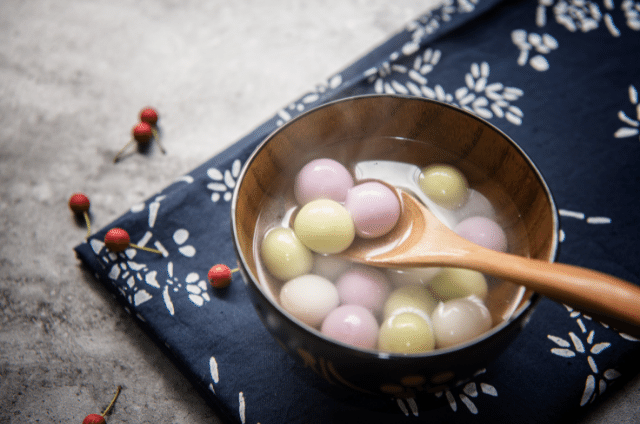
This dish’s name varies depending on what region of China you’re in during the Lunar New Year celebration. However, this is the most common variation, stemming from the term, “tuan yuan,” which roughly translates to “family reunion.”
You’re most likely to find this dish in New Year celebrations in southern China, primarily due to the difference in cultivation between the two regions. The South is much better suited to large-scale rice production than the North, so their resources for the dish are far more plentiful.
The North now has greater access to rice-based meals thanks to modern amenities. So, their cuisine centers more heavily on wheat and millet because of these environmentally-influenced cultural differences.
Traditionally, celebrators fill these sweet bites of rice with a sweetened blend of sesame seeds, peanuts, and red beans. As shown by commercial and Western producers, this is not required. Some who prepare this dish opt for chocolate and other decadent ingredients instead. Below is an example of how you can prepare your nian gao.
How to Make Tangyuan
Lots of people are intimidated by the though of making tangyuan at home. Yet, when you give yourself a chance, you’ll find that the process really isn’t too bad! Since this dish signifies family reunion, feel free to invite your loved ones into the process alongside you. When you’re all together, follow these steps to make your own tangyuan
- Roast 130g black sesame seeds over low to medium heat.
- Note: It’s challenging to know whether black sesame seeds are fully roasted or not. Toss in some white sesame seeds, and when they’re brown, your seeds are done.
- Grind the roasted seeds in a coffee grinder until they form dense clumps. Be careful not to pass this point. Otherwise, you’ll end up with tahini.
- Spoon 3 tbsp of room temperature coconut oil or butter in a pot.
- Add 40g of palm sugar.
- Add ¼ tsp of salt.
- Cook mixture over low heat until the sugar has completely melted.
- Add the ground sesame seeds.
- Once the mixture has formed a paste, remove it from the heat and allow it to cool.
- Break up 100-150g of ginger root in a mortar and pestle. (Feel free to do less if you are sensitive to spice.)
- Add it to 6 cups of boiling water, and simmer for 20 minutes.
- Mix 175g of glutinous rice flour with 150-175 ml of water.
- Note: Be very careful here. Adding too much water will make your dough too runny. You’re looking for a slightly stiff, non-sticky dough.
- Take the cooled sesame paste and form it into small 9g balls.
- Freeze the sesame paste balls.
- Strain the ginger tea and add 4 tbsp of dark brown sugar.
- Weigh 13g of dough per sesame ball and wrap the dough around the balls.
- Boil the balls for 15 minutes each. Place them in a bowl of room temperature water to prevent them from sticking.
- Serve the balls in a bowl with hot ginger tea poured over the top.
Yúshēng (“Raw Fish”)

In Chinese, “Yúshēng” can be spelled two distinct ways, each with a specific meaning. While one, 鱼生, means “abundance,” the other (余升) has a slightly different definition, “increase in abundance.” These two terms combine to define the seventh day of the new year, the “Birthday of Men,” to represent
- Abundance
- Wealth or affluence (not exclusive to economic standing)
- Vitality
Why does this dish hold so much importance, specifically on the seventh day of the New Year? Like the Buddhist vegetarian dish, Jai, eaten on the final day of the 15-day Chinese New Year celebration, observers choose to eat fish to honor life and respect the goddess, Nüwa’s, creations. For this reason, the following fish and salad is a common alternative to entirely vegetarian meals in homage to Nüwa
- Catfish
- Chinese mud carp
- Crucian carp
Yúshēng Recipe Made Easy
There are so many different ways to make yúshēng, so please don’t feel obligated to make one form of the dish. Remember that the star of the meal is fish. So, as long as you include the raw fish (some meals even allow whole, cooked fish, or yú), you can choose whatever Lunar New Year-appropriate side dishes you please.
Here is one example of how Chinese families enjoy yúshēng in the New Year:
- Cut 8-10 dumpling wrappers into strips.
- Fry the strips in cooking oil for 10 seconds.
- Dice 6 shallots and fry them until they’ve turned a light brown color.
- Beat 2 eggs with ½ tsp of salt and fry them together to make one large disc (like an unfolded omelet).
- Cut the fried egg into thin strips and set aside
- Grind 20g of roasted sesame seeds and 100g of roasted peanuts in a food processor.
- Mix 4 tbsp of plum sauce with an equal amount of water.
- Thinly slice 150g of red cabbage.
- Thinly slice a whole, fresh carrot and cucumber longways.
- Dice up a pomelo, shinko pear, or other preferred Lunar New Year fruits.
- Plate as desired, with pickled onion, kaffir lime leaves as garnish, and your chosen raw yú (fish) on top.
Jiaozi (Dumplings)
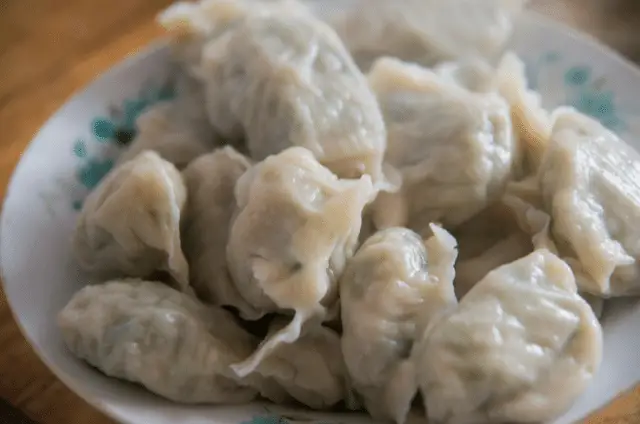
Jiaozi is a popular dish that families enjoy preparing together. Like the nian gao, it wasn’t always eaten on the dawn of the Lunar New Year. Instead, it was originally a winter solstice dish, first prepared by a Han Dynasty-era doctor named Zhang Zhongjing.
Zhongjing created the dish out of concern for people who had fallen ill due to the harsh weather. That winter, his dish, complete with lamb and various vegetables and herbs, saved many disenfranchised Chinese citizens from succumbing to the cold. He persisted in this practice for 30 years, and millions of families across the country still prepare the meal each year in remembrance of his servitude.
Later, the Ming Dynasty set the precedent that the dish would be added to the list of traditional New Year celebratory dishes. Many at the time considered it instrumental in the accumulation of wealth in the future since the dumplings’ shape was similar to that of a silver ingot. (The silver ingot was a type of currency first used during the 9th century.)
How to Make Jiaozi
Dumplings can stand on their own or be a part of a larger meal. As with nearly all Chinese New Year recipes, there are so many ways to prepare jiaozi, and the recipe below represents a uniquely savory approach
- Mix 500g of white baking flour with 200 ml of lukewarm water, little by little to form a soft, non-sticky dough. Cover it with plastic wrap while you continue working.
- Chop Chinese chives into small pieces.
- Marinate ground beef with 2 tsp of salt, 2 tsp of potato starch, 2 tsp light soy sauce, 1 tsp sesame oil, 1 tbsp oyster sauce, and 100 ml of water.
- Add the Chinese chives.
- Break off pieces of the dough to make small balls.
- Flatten the balls and fill them with the ground beef filling.
- Enclose the balls and pinch the top lengthwise, making folds to help it adhere better.
- Boil the jiaozi in a covered pot. The dumplings are ready when they float.
- Pan fry for a crispy outside, or serve them after boiling, whichever you prefer.
- Enjoy!
Luo Buo Gao (Turnip Cake)

These cakes are similar to nian gao; however, they are significantly more prevalent among Cantonese families at this time of year. As a staple in Cantonese Lunar New Year celebrator dishes, luo buo gao represents good fortune.
The dessert is also quite popular in Taiwan, where its meaning is made clear by the name’s similarity to the term “cai tao gui,” which is a homonym for the term meaning “future” in English. The dish also maintains close linguistic relationships with the term, “hao cai tao,” which translates to “good luck.” The turnip itself embodies all these definitions and acts as a symbol of good omens.
Turnip cakes can be served in various ways. However, the two most popular options are fried or steamed dishes. The cake has been popularized and commercialized throughout the world, especially in cultural melting pots like Los Angeles. Yet, it retains its place as one of the main, most cherished dishes for welcoming the New Year among Chinese and Taiwanese families.
Instructions for Making Luo Buo Gao
Turnip cake is a widespread favorite amongst Lunar New Year celebrators. You can either prepare it at home with your loved ones or go out and enjoy the dish made by a professional chef. As mentioned above, it’s become so popular that you don’t have to wait until the New Year to taste this flavorful meal. To make it on your own, follow the recipe below:
- Dice Japanese mushrooms and Chinese preserved meat into small cubes.
- Peel your turnip and cut it into 1cm slices.
- Mix rice flour, cornstarch, salt, sugar, and white pepper together until smooth. Set it aside
- Fry diced meat, mushrooms, and turnips over medium heat along with Supreme dried shrimp, dried scallops, and Chinese sausage.
- Place the fried ingredients into the batter.
- Steam for 45 minutes over high heat and cool overnight.
- Cut the cakes into squares and fry evenly on both sides.
- Enjoy!
6. Lo Han Jai (“Buddha’s Delight”)
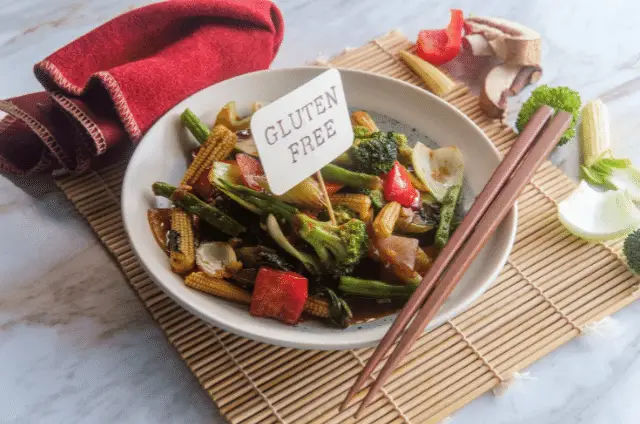
Jai is a Buddhist vegetarian dish, typically prepared on the first day of Chinese New Year. It is made with 18 ingredients, as this is a lucky number. This dish represents wealth and prosperity, and each element contributes a unique symbology to the plate. Plus, this dish’s importance as a vegetarian option speaks directly to the need to abstain from consuming meat on the first day of the Chinese New Year.
Avoiding meat consumption on the first day of a brand-new year is believed to increase longevity. Plus, purely plant-based food is thought to cleanse the body of toxins. Lastly, it honors the Buddhist tradition of avoiding taking life on the first day of the New Year. Violating this tradition is believed to bring bad karma (for Buddhist monks, this applies year-round, not just on the New Year’s first day).
There is no one way to make jai, as it’s known for short (or “luo han zhai,” in Cantonese), yet there are several common ingredients that each add great significance to the dish, such as:
- Bamboo shoots = New beginnings
- Noodles = Longevity
- Fat choy = Affluence
- Note: This ingredient’s name sounds similar to a Cantonese greeting, 恭喜发财, that translates to “congratulations, and be prosperous”).
- Water chestnuts = Unity
How to Make Jai
Jai is a dish full of meaning and significance for the upcoming year. It’s perfect for those looking to adhere to their vegetarian diet or aiming to respect the fragility of life on the first day of the New Year, as Buddha taught. Still, you don’t have to give up a savory taste in the absence of meat. This recipe fully demonstrates the dish’s flavor-packed profile:
- Heat a stir-fry pan over medium heat with about 1 tbsp of oil.
- Add 4 pieces of rehydrated dried mushrooms first, for about 1 minute. This will flavor the oil for the rest of the ingredients.
- Add carrot slices.
- Mix 1.5 tbsp of sesame oil and 1 piece of fermented bean curd and add it to the pan.
- Add 2 tbsp of vegetarian oyster sauce, 500g of cabbage, ½ tsp of salt, 2 cups of water that you used to rehydrate the mushrooms.
- Cover and simmer for 10 minutes.
- Add 1 tbsp of light soy sauce and ½ tsp of sugar. Stir.
- Add 80g of black fungus, 75g snow peas, 35g of tanghoon (also known as “glass noodles”).
- Cover and simmer for 3-5 minutes.
- Add cornstarch to thicken the sauce, stirring as you go.
- Enjoy!
Spring Rolls
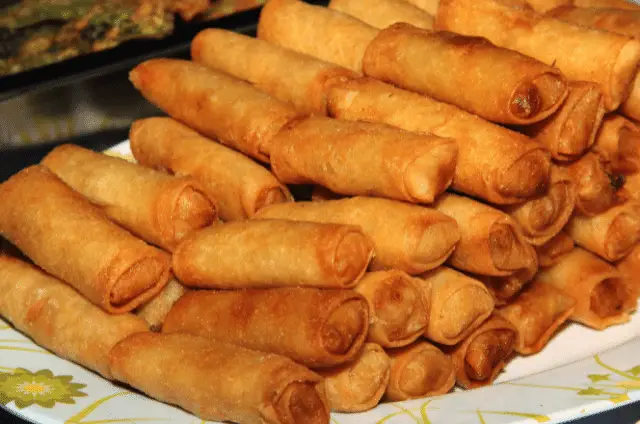
Due to their massive popularity in Western culture, spring rolls’ cultural significance has been numbingly white-washed. In traditional Chinese culture, these foods hold tremendous value, especially in the context of the Chinese New Year. Their namesake comes from the Chinese Spring Festival, known locally as “wei,” although they’re eaten all year-round.
This is another dish that symbolizes monetary prosperity, as the roll’s shape is similar to that of a gold bar. The roll’s color is crucial to their symbolism, so it is so important to cook them to a glowing golden hue.
Egg rolls are yet another dish marked by differences in consumption between the Northern and Southern Chinese regions. Northern Chinese people tend to eat more spring rolls than their southern counterparts, yet the dish is popular among both demographics.
Making Spring Rolls
There is no one way to make spring rolls. While some people prefer them to be vegetarian, others like to include seafood in the dish. One example that combines these two ingredients and flavor profiles is described below:
- Devein and boil shrimp with the shell on. Cut the shrimp in half, then remove the shell. Set aside
- Cut the tofu and ham into ½”-wide strips.
- Take a sheet of rice paper and submerge it into warm water. Remove it after just a few seconds, placing it onto a clean wooden surface (or another cutting board).
- Stack the following ingredients on top of the rice paper:
- Lettuce
- Sawtooth coriander
- Mint
- Cilantro
- Bean sprouts
- Cooked rice vermicelli noodles
- Beside these vegetables, add the tofu and ham strips and shrimp.
- Roll the rice paper, completely enveloping all the ingredients.
- Serve with a dipping sauce of choice.
Whole Chicken
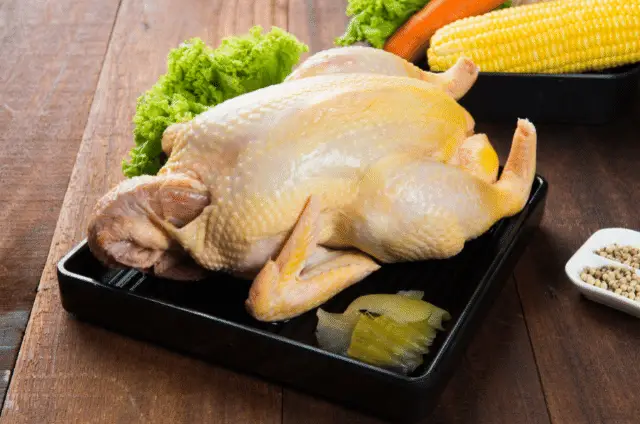
One of the foundational themes surrounding the Chinese New Year is that of togetherness and unity. These meanings directly contribute to the significance of serving an entire chicken during the Lunar New Year celebrations.
Now, these chickens aren’t the typical “whole” chicken that Westerners are accustomed to serving at their dinner tables. No, those consumed in traditional Chinese Lunar New Year dishes retain their head, feet, and tail. Keeping all of the chicken’s body parts attached is symbolic of, well, wholeness and being complete in one another’s company.
Additionally, eating chicken specifically during this celebratory period is symbolic of prosperity and cheerfulness. A meal featuring this particular poultry is believed to heighten all partakers’ chances of experiencing these positive sentiments the whole year round (since the chicken’s head and feet signify the whole coming year, from “beginning” to “end”).
How to Prepare Whole Chicken
One of the most important factors to remember about preparing whole chicken for the Chinese New Year is that you need to leave the full chicken intact. This means keeping the head, feet, and tail. These are tough to find in Western grocery stores and markets, so you may want to buy straight from a farmer or test your luck at an Asian market.
Once you’ve got your chicken, follow the steps below to prepare your meal:
- Rinse the whole chicken to ensure it’s clean.
- Rub approximately 1 tbsp of salt over the entire chicken.
- Stuff the chicken with a mixture of:
- 3 tbsp green onion, chopped
- 3 tbsp ginger, chopped
- 1 tsp salt
- 1 tbsp brown sugar
- 1 tsp chicken base – not chicken stock or broth!
- 1 tbsp garlic, chopped
- Steam the chicken for 25-30 minutes, covered.
- Pour the chicken’s excess liquid when it’s nearly done, and cover for 2 more minutes.
- Allow it to cool before carving.
- Sautee 1.5 cups of ginger with 1 tsp of salt, ½ tsp sesame oil, and ½ of chicken base.
- Add 1.5 cups chopped green onions and serve underneath diced chicken.
Lotus Root Stuffed with Pork
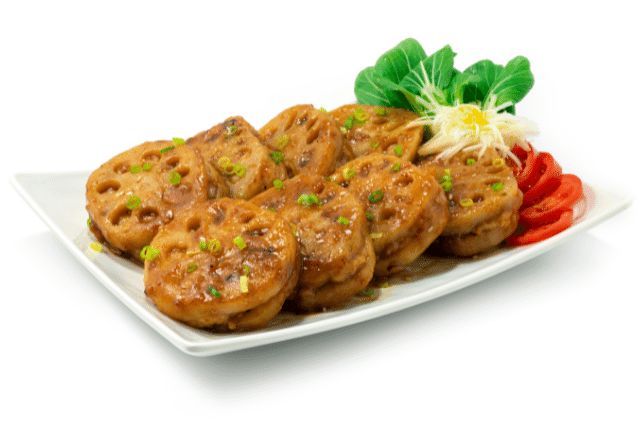
This dish holds a special place in many people’s hearts, thanks to the individual significance of several different meal components. First, there is the lotus root. This is a bit of a tricky ingredient to understand in terms of symbology, as it is not generally consumed for the importance of the root itself, but the seeds (also occasionally referred to as “nuts”).
Those who eat lotus seeds during the Lunar New Year guarantee themselves financial wealth and fertility, particularly for the birth of many sons. The pork amplifies the gift of great economic prosperity in the coming year, along with the granting of strength and generally positive blessings the year-round.
Interestingly, even the oil used to cook the food is symbolic. During the 1990s and ’80s, oil was quite an expensive commodity to acquire, which is fried meals were typically restricted to the holidays. Even when celebrators could afford it, the supply was limited per family. So, dishes like the pork-stuffed lotus root were very special because of all it took to gather its ingredients.
Nowadays, all these components are much easier to come by. Still, although you no longer have to worry about whether you’ll be able to collect all you need to make it, the memory of such times past helps the dish to retain its renown among observers of the Lunar New Year.
Cooking Pork-Stuffed Lotus Root
This meal is surprisingly easy and quick to make – at least, if you’re careful not to break all your lotus root slices! This root has the same texture as freshly cut and shaved potatoes. So, if you cut them too thin, handle them too roughly, or stuff them excessively, root slices will crack. Be mindful of this when following the recipe below:
- Season minced pork with soy sauce, pepper (to taste), 1 tsp of sesame oil and marinate for 15 minutes.
- Slice lotus root.
- Sandwich the pork between two lotus root slices. Set aside.
- Mix 4 tbsp of cold water with 100g of all-purpose flour.
- Dip the stuffed lotus roots into the batter, making sure all sides are covered.
- Fry the stuffed lotus roots until golden.
- Let cool, and enjoy!
In Conclusion
The Chinese New Year menu is always overflowing with meals that will bring you great wealth, good luck, and happiness in the upcoming life chapter. Desserts like nian gao elevate you to a higher position in life and blesses children’s growth, while dishes like whole chicken help to unify your family in the present and future.
With these dishes listed above, you can enjoy your Lunar New Year with a full belly and assurance of a prosperous life in the time to come.
